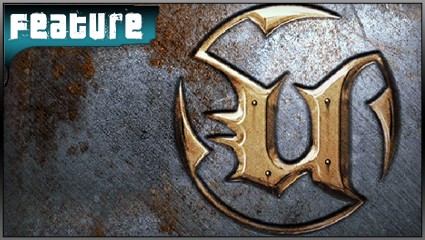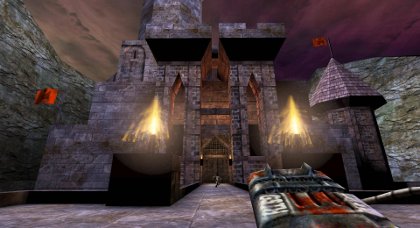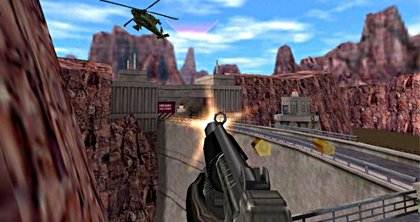The third part of Kristan’s epic retrospective.
1998 proved to be a watershed year for the First Person Shooter, with several present-day heavyweights making their hugely impressive debuts and bringing about a genre-wide shift in power.
The release of Epic Games’ long-awaited Unreal on PC in May of that year dovetailed perfectly with the emergence of 3Dfx’s awesome Voodoo 2 3D accelerator. Suddenly PC gamers (with deep pockets) were being treated to the kind of super-smooth, high resolution visuals that rivalled anything the arcade could offer at the time.
Epic’s ground-breaking Unreal tech provided gamers with more of everything. More sophisticated enemies, bigger and more architecturally intricate environments, as well as vastly improved texturing, lighting and particle effects. Also significant was that Unreal delivered sprawling outdoor areas: exploring those opulent environments set the game aside from the claustrophobic corridor shooters we’d long grown accustomed to.
Another landmark title followed later that in 1998 in the shape of Valve Software’s Half-Life. Released in November after two years in development, it single-handedly changed the single player FPS landscape forever. One of the first games to license id’s Quake engine tech, this sci-fi masterpiece was a stupendous opening salvo for Valve, blending great action with subtle, scripted narrative. It sired a long line of cinematic, story-driven videogames.
As with Unreal, Half-Life’s focus was very much on the single player experience. It embroiled players in a narrative tour de force like nothing before. The game’s approach was more subtle, more enigmatic and far more convincing thanks to superb characterisation, excellent voiceovers and a compelling premise which made the game, at times, feel every bit as absorbing as a classic sci-fi blockbuster.
It had no cutscenes, and no traditional levels as such: the game’s ‘chapters’ unfolded end to end in front of you. The action itself was enhanced by naturalistic AI techniques and a variety of settings. Its Quake-powered visuals were a touch behind the times, but in every sense that mattered it was years ahead.








 Satoru Iwata Video Interview - the late Nintendo president spoke with Kikizo in 2004 as 'Nintendo Revolution' loomed.
Satoru Iwata Video Interview - the late Nintendo president spoke with Kikizo in 2004 as 'Nintendo Revolution' loomed. Kaz Hirai Video Interview - the first of Kikizo's interviews with the man who went on to become global head of Sony.
Kaz Hirai Video Interview - the first of Kikizo's interviews with the man who went on to become global head of Sony. Ed Fries Video Interview - one of Xbox's founders discusses an epic journey from Excel to Xbox.
Ed Fries Video Interview - one of Xbox's founders discusses an epic journey from Excel to Xbox. Yu Suzuki, the Kikizo Interview - we spend time with one of gaming's most revered creators.
Yu Suzuki, the Kikizo Interview - we spend time with one of gaming's most revered creators. Tetris - The Making of an Icon: Alexey Pajitnov and Henk Rogers reveal the fascinating story behind Tetris
Tetris - The Making of an Icon: Alexey Pajitnov and Henk Rogers reveal the fascinating story behind Tetris Rare founders, Chris and Tim Stamper - their only interview? Genuinely 'rare' sit down with founders of the legendary studio.
Rare founders, Chris and Tim Stamper - their only interview? Genuinely 'rare' sit down with founders of the legendary studio. The History of First-Person Shooters - a retrospective, from Maze War to Modern Warfare
The History of First-Person Shooters - a retrospective, from Maze War to Modern Warfare
Quake 3 was better than UT…which is why it still gets played a decade later.
UT died on it’s ass.
Q3 continued to be played throughout worldwide competitions “professionally”.